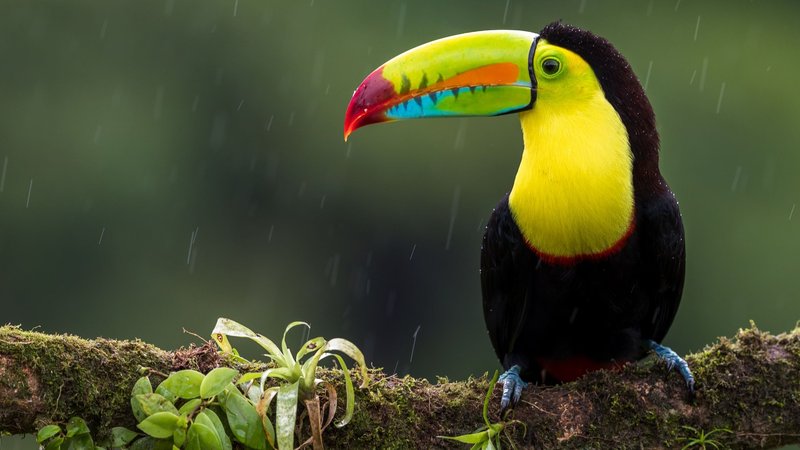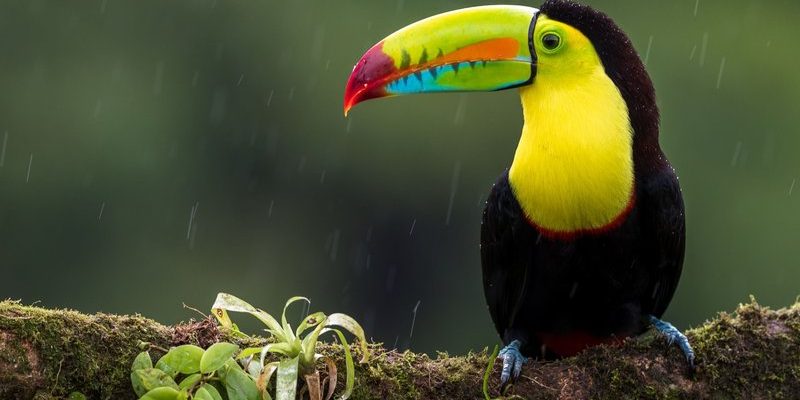
Have you ever seen a toucan? These birds are nothing short of nature’s living rainbows! With their vibrant plumage and those iconic oversized beaks, to see a toucan is like stepping into a tropical painting. They are more than just pretty faces, though; these fascinating creatures play vital roles in their ecosystems. So, let’s dive into the colorful world of toucans, exploring their traits, behaviors, and habitats.
Toucans belong to the family Ramphastidae and are primarily found in Central and South America. When you think of tropical rainforests, you might picture lush greenery and diverse wildlife, and toucans are right at home among the branches. Each species has its unique charm, and their striking colors can vary widely—from vibrant yellows and reds to deep blues and greens. Let’s break down everything you need to know about these magnificent birds!
Physical Characteristics
Toucans are best known for their unique beaks, which can measure up to 8 inches long. You might wonder how such a large beak aids in their daily life. Here’s a little secret: while it looks heavy, a toucan’s beak is surprisingly lightweight, made of a foam-like keratin material. Their beaks aren’t just for show; they help in grabbing fruit, which is a primary food source. In fact, a toucan’s diet mainly consists of fruits, but they will also munch on insects and small reptiles when the opportunity arises.
Beyond their impressive beaks, toucans sport bright feathers that come in various patterns and colors. The most well-known species, the Keel-billed toucan, displays a striking combination of yellow, green, and red plumage. Each species has a unique color palette, making them perennial favorites for bird watchers and photographers alike.
While toucans may look drastically different from other birds in your neighborhood, they actually share some similarities with woodpeckers and hornbills. Their zygodactyl feet, with two toes facing forward and two backward, help them grip branches securely, which is essential for their arboreal lifestyle.
Habitat and Distribution
Toucans thrive in tropical and subtropical forests, residing mainly in the canopies where the sunlight filters through. These birds are expert climbers and prefer high perch points to spot their next meal. You’ll typically find them in Central and South America, from the lush jungles of the Amazon to the mountainous forests of Costa Rica.
Interestingly, toucans are social birds. They often live in small flocks, which provides safety in numbers as they navigate through the treetops. This social behavior is essential in finding food and avoiding potential predators like hawks and snakes. Additionally, toucans help disperse seeds from the fruits they consume, playing a critical role in maintaining the health of their forest ecosystems.
Climate change and habitat destruction pose significant threats to toucan populations. As rainforests shrink, these beautiful birds face a growing risk of extinction. Conservation efforts are crucial to protect their habitats and ensure future generations can enjoy the sight of toucans in the wild.
Behavior and Diet
Toucans are primarily fruit eaters, but they’re known to have a diverse diet that can include insects, small mammals, and even eggs. Their long beaks are perfectly designed for reaching out to grab fruit from hard-to-reach branches. They are also known to engage in a bit of friendly competition when it comes to feeding. You might see them tossing fruit to each other, which isn’t just play—it’s a way to strengthen social bonds within their flocks.
One of the most fascinating behaviors of toucans is their vocalization. They use a series of caws, clicks, and grunts to communicate with one another, making them quite the chatty bunch. Their sounds can carry through the rainforest, helping them stay connected even when separated by layers of vegetation.
During the breeding season, toucans exhibit unique nesting behaviors. They typically nest in tree cavities, often using old woodpecker holes. The female will lay a small clutch of eggs, usually between 2 to 4. Both parents share the responsibility of incubating the eggs and feeding the chicks once they hatch. This teamwork is essential for the survival of the young, who are helpless at birth and rely entirely on their parents.
Reproduction and Lifespan
Toucans generally breed once a year, with the timing varying according to the species and geographical location. After a courtship display involving energetic movements and vocalizations, the female toucan will lay her eggs. Depending on the species, incubation lasts about 16 to 20 days.
Once hatched, the chicks are born blind and featherless, requiring full parental care to survive. The parents will feed them regurgitated fruit and insects, an act that strengthens their bond. Over the next several weeks, the chicks grow rapidly and begin to develop feathers, eventually leaving the nest within 6 to 9 weeks after hatching.
In the wild, toucans can live around 10 to 20 years, depending on the species and environmental conditions. In captivity, they have been known to live even longer. This longevity highlights the importance of caring for their habitats and ensuring that they have the resources they need to thrive.
Conservation Status
The charming toucan captivates the hearts of many, but they are facing serious threats. Deforestation and habitat loss due to agriculture and urban expansion are significant issues impacting their populations. Various species of toucans, such as the Pico de Loro toucan, are classified as near threatened or vulnerable.
Conservation efforts are underway in many regions to preserve the habitats of these beautiful birds. Organizations are focusing on reforestation projects, habitat protection, and community education to help local populations understand the ecological importance of toucans and their role in seed dispersal.
Additionally, ecotourism has emerged as a powerful tool in conservation. By promoting responsible wildlife tourism, local communities can benefit economically while preserving the rainforest habitats that toucans and many other species rely upon. Supporting these initiatives is crucial for ensuring the survival of toucans for generations to come.
Interesting Facts about Toucans
| Fact | Detail |
|---|---|
| Species Count | There are over 40 different toucan species. |
| Beak Length | Their beaks can measure up to 8 inches long. |
| Diet | Primarily fruits, along with insects and small animals. |
| Social Structure | They live in small flocks and are highly social. |
| Breeding | Eggs are laid in tree cavities and both parents care for the chicks. |
| Lifespan | 10 to 20 years in the wild; longer in captivity. |
FAQ
What is the most common species of toucan?
The Keel-billed toucan is often considered the most iconic and recognizable species due to its vibrant colors and striking beak. Found in Central America, it has a wide range and is commonly featured in nature documentaries and wildlife photography.
Are toucans good pets?
While toucans may seem like charming companions, they have very specific care requirements that can be challenging to meet in a home setting. They need a spacious aviary to fly and climb, a specialized diet, and a social environment. For most people, it’s best to enjoy toucans in their natural habitat or through responsible wildlife tourism.
How do toucans help the environment?
Toucans play a crucial role in their ecosystems as seed dispersers. When they eat fruit, they help distribute seeds across the forest floor through their droppings. This process contributes to forest regeneration and biodiversity, making toucans essential for maintaining healthy ecosystems.
Can toucans be found outside of Central and South America?
Toucans are primarily native to Central and South America, but their popularity has led to some being kept in zoos and aviculture worldwide. However, they are not naturally found outside their native habitats, as they thrive in specific tropical environments.
How loud are toucans?
Toucans can be quite vocal, and their calls can carry across the rainforest. Their sounds range from low grunts to croaky calls. While they are not the loudest birds in the forest, you’ll definitely hear them interacting with one another if you’re nearby!
Do toucans mate for life?
Toucans are not strictly monogamous and do not mate for life. They typically form pairs during the breeding season, but they may change partners in subsequent years. Their social structure often allows for a bit of flexibility in relationships.
What kind of tree do toucans nest in?
Toucans prefer to nest in tree cavities, which are often old holes made by woodpeckers. They choose tall, sturdy trees that provide a safe environment for their chicks, away from potential predators.
Are toucans endangered?
While not all toucan species are endangered, some face threats from habitat loss and climate change. Conservation efforts are essential to ensure their populations remain stable and they can continue to thrive in their natural environments.
What do toucans eat in the wild?
In the wild, toucans primarily eat fruit, but their diet can also include insects, small reptiles, and even bird eggs. They are opportunistic feeders and will adapt their diet based on the availability of food in their habitat.
How can I help toucans?
You can help toucans by supporting conservation organizations that focus on habitat protection and restoration. Additionally, promoting sustainable practices and responsible ecotourism can help create a positive impact on their populations and habitats.
What adaptations help toucans survive in the wild?
Toucans have several adaptations that aid in their survival, such as their lightweight beaks for fruit gathering and their zygodactyl feet for climbing. Their vibrant colors help them blend into their surroundings, providing camouflage from predators.

